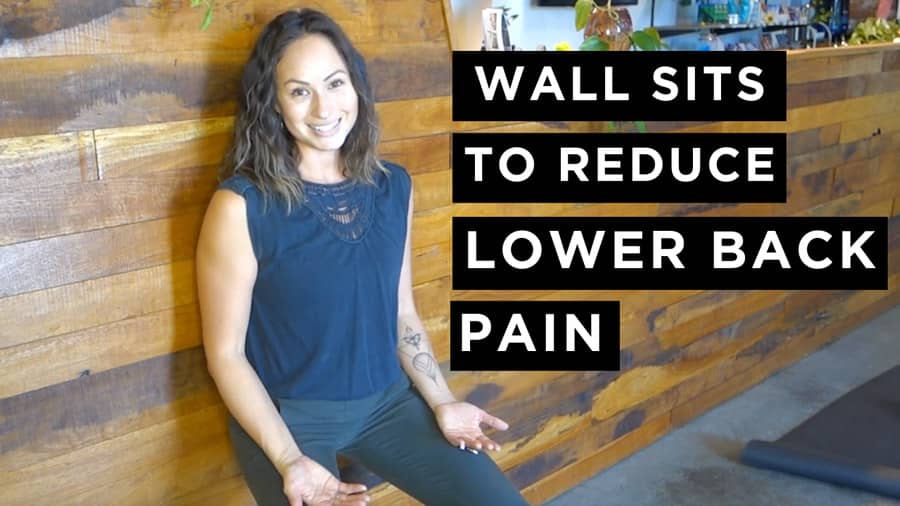We know that the majority of us will experience back pain at some time in their lives, and we also know that if you have suffered with it you just want it gone yesterday! So we decided to give you one of our favourite exercises to prescribe to our clients that will help, no matter what your unique situation.
Did you know the average Australian spends more than 12 hours of a 16-hour waking day sitting, according to the Annals of Internal Medicine? That means most people spend more time sitting than they do sleeping. Not only is sitting one of the least active things you can do (duh), it actually negatively affects your body: There’s the things you can feel, like tight hips and low back pain. But studies also show it can up your risk for depression, diabetes, and other causes of mortality without you even noticing. Not great.
But as someone who works on a computer, sitting is an unavoidable part of my day. So, what if I could make some of that sedentary time feel a little more active?
Enter: wall sits.
The wall sit exercise is often overlooked as an exercise due to its simplicity in nature. However it is it’s simplicity that makes it so good for you!
A simple wall sit exercise can reduce lower back pain and the effects of sitting at a desk all day.
What Is the Wall Sit?
Wall sits are an isometric exercise – meaning that you hold the one position for a period of time. The wall sit requires you to hold yourself in a seated position (without a chair). It predominantly works your glutes, quads, hamstrings, abdominals …and your dedication.
A handy feature of the wall sit is that you require no exercise to perform it – perfect for doing at home! All you need is a wall or any other vertical surface to lean against and you’re good to go!
Here are a few benefits of the wall sit and why you should consider incorporating this exercise in your workout routine.
The Benefits of Wall Sits
Works your entire lower body
Even though the wall sit is an isometric/static exercise, it can still be considered a compound exercise as it requires numerous joint and muscles to work in unison. Wall sits work your entire lower body – your glutes, your hamstrings, and your quads. The main purpose of this exercise is not to increase muscle mass, but to increase muscular endurance (which is one of the main things that people suffering with low back pain need to work on). You will notice that you will be able to hold a wall sit for longer and longer periods of time over time.
There are not many lower body isometric exercises that require the use of all your major leg muscles, so the wall sit is considered unique in this way.
Increases your endurance
We’ve covered that the wall sit isn’t necessarily for building muscle mass, nor should it be your go-to exercise for strength. But the wall sit will improve your muscular endurance.
How does it do this? By activating the Slow Twitch Fiber (or Type I Fiber) components of your muscles. These muscle Fibers are responsible for your endurance, rather than your strength, which falls under the responsibility of Type II Fibers, or fast-twitch Fibers.
So, if you are a distance runner or someone who plays a running sport (such as basketball or football) you would benefit a lot from wall sits.
An alternative to squats
If you can’t perform squats for whatever reason, wall sits are a great alternative that will work the same muscle groups. If you can perform squats though, the wall sit should not be an alternative, but rather a supplementary exercise.
Can be done anywhere
Probably one of the most important advantages of the wall sit is that you can do them anywhere, at any time and without any equipment needed. This is a huge benefit if you don’t have the time to go to a gym.
Fun to do
For some (surprising) reason, a lot of people simply enjoy doing wall sits. They are a great family challenge!
How To Do Wall Sits Correctly
Getting the hang of wall sits is easy and the exercise itself is straight forward. Having said this, there are still a couple of things to look out for. So, here’s how to do it correctly:
For starters, in a standing up position, lean against your vertical surface of choice.
Next, walk your feet out away from the wall (once in your wall sit position, your knees should not track over your toes), and have them wider than shoulder width apart. While leaning back on the wall, slide down until there is a greater than 90-degree bend at both your hips and knees.
Hand placement can be on the wall next to you or crossed in front of you but should not be placed on your thighs, unless you are a beginner requiring some assistance to start off with. Placing the hands on your thighs will make the exercise less difficult.
Your back should be leaning against the wall with your head, neck, and spine in a neutral position.
And that’s how you get into a perfect wall sit position!
You will know you are doing it right if you feel your body weight in your heels, not in your toes, and your quads and hamstrings starting to burn after 15 to 20 seconds.
Another important thing to remember is that when you fatigue you should push/slide yourself up against the wall back to standing position. Don’t crumble down to the ground. It can cause a lot of damage to your knees, especially when your muscles, tendons, and ligaments are fatigued.
Watch this:
What Are Wall Sits Good For?
- Increasing quad stamina
- Improving stability of the pelvis
- Building strength
How Long Should You Do Wall Sits?
Ideally, you should do wall sits for 30 to 60 seconds in sets of 3. If you are a beginner then hold it until you feel like your muscles are working to 60% of their optimal, then
Our challenge for you
We challenge you to start adding a couple of sets of wall sits to your workout. If you happen to be not training at all, start by doing a couple of sets of wall sits a week. Write down your wall sit hold time on a piece of paper and review your progress after 4 weeks. You will be amazed by the results.
Also please note that severe back pain after an injury should be evaluated by a health-care professional. Warning signs of more serious injury include pain with coughing or urinating, loss of control of the bowels or bladder, new leg weakness, and fever. These additional symptoms require medical evaluation.
We can’t wait to hear of your results!
Got more questions about lower back pain? We have answers! Leave us a comment below and we will be HAPPY to give you more information.
And don’t forget to share this with any loved ones who you think might benefit from them!
Until next time …
Yours in great health,
Dr Andy & Dr Jacinta

References:
http://www.dssimon.com/MM/ACP-sedentary-study/Tracking_Sedentary_Time_and_Mortality.pdf
